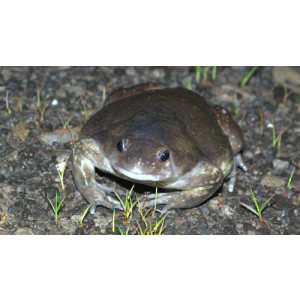Chittagong Microhylid Frog Did you see this animal?
Scientific Name : Microhyla mukhlesuri
Family : Microhylidae
Order : Anura
Class : Amphibia
Phylum : Chordata
Other Name : Chittagong Microhylid Frog, Mukhlesur’s Narrow- mouthed Frog
Habitat : Forests
Description : Mukhlasur's narrow mouth frog has a narrow mouth and a pointed snout that allows it to feed on small insects and invertebrates.
This species is small, typically measuring between 2.5 and 3.5 centimeters in length. Mukhlesur's narrow-mouthed frog is found in a variety of habitats, including forested areas, grasslands, and agricultural land. It is a semi-aquatic species and is often found near ponds, streams, and other bodies of water.
This frog species is typically brown or gray in color, with dark stripes or spots on its back. It has a rounded body and short, stubby legs that enable it to jump and climb on vegetation. The males are slightly smaller than the females, and during the breeding season, they develop dark pads on their thumbs that help them to grip onto the female during mating.
It is most active at night. During the day, it can be found hiding in vegetation, under rocks or in burrows. It has the ability to camouflage itself very well, making it difficult to spot.
This frog species is known for its distinctive call, which is a high-pitched "cheep-cheep" sound. The males use this call to attract females during the breeding season, which typically takes place between June and September.The female lays her eggs in shallow water, and the male fertilizes them externally. The eggs hatch into tadpoles, which undergo metamorphosis into adult frogs.
This frog feeds on small insects and invertebrates, including ants, termites, beetles, and spiders. It has a narrow mouth that allows it to catch its prey with precision.
Mukhlesur's narrow-mouthed frog plays an important role in its ecosystem by helping to control populations of small insects and invertebrates. It is threatened by habitat loss, pollution, and climate change. Conservation efforts are needed to ensured to preserve them for upcoming generations.
This species is small, typically measuring between 2.5 and 3.5 centimeters in length. Mukhlesur's narrow-mouthed frog is found in a variety of habitats, including forested areas, grasslands, and agricultural land. It is a semi-aquatic species and is often found near ponds, streams, and other bodies of water.
This frog species is typically brown or gray in color, with dark stripes or spots on its back. It has a rounded body and short, stubby legs that enable it to jump and climb on vegetation. The males are slightly smaller than the females, and during the breeding season, they develop dark pads on their thumbs that help them to grip onto the female during mating.
It is most active at night. During the day, it can be found hiding in vegetation, under rocks or in burrows. It has the ability to camouflage itself very well, making it difficult to spot.
This frog species is known for its distinctive call, which is a high-pitched "cheep-cheep" sound. The males use this call to attract females during the breeding season, which typically takes place between June and September.The female lays her eggs in shallow water, and the male fertilizes them externally. The eggs hatch into tadpoles, which undergo metamorphosis into adult frogs.
This frog feeds on small insects and invertebrates, including ants, termites, beetles, and spiders. It has a narrow mouth that allows it to catch its prey with precision.
Mukhlesur's narrow-mouthed frog plays an important role in its ecosystem by helping to control populations of small insects and invertebrates. It is threatened by habitat loss, pollution, and climate change. Conservation efforts are needed to ensured to preserve them for upcoming generations.
Distribution in Bangladesh
References:
description written by: Md. Shalauddin, Department of Zoology, Jagannath University, Dhaka. Information sources: Hasan et. al 2014, IUCN Red List Bangladesh-2015photo credit:jonhakim(www.inaturalist.org/people/jonhakim),photo copyright: iNaturalist. more information please contact with us.
description written by: Md. Shalauddin, Department of Zoology, Jagannath University, Dhaka. Information sources: Hasan et. al 2014, IUCN Red List Bangladesh-2015photo credit:jonhakim(www.inaturalist.org/people/jonhakim),photo copyright: iNaturalist. more information please contact with us.
















